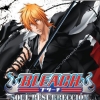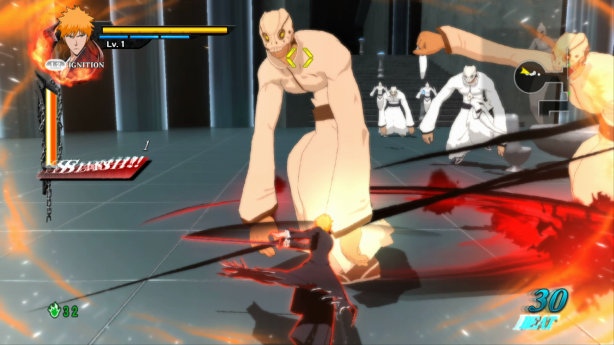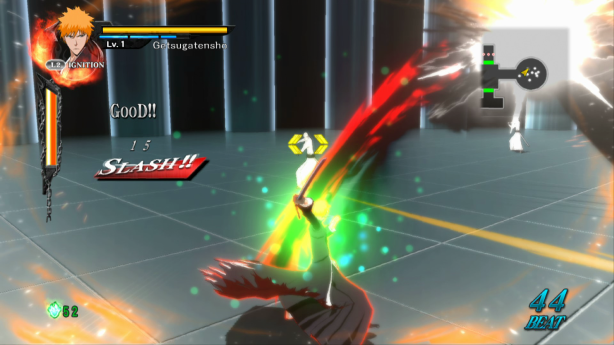Bleach: Soul Resurrección Review
 Game: Bleach Soul Resurreccion
Game: Bleach Soul Resurreccion
Developer: SCE Japan Studio
Publisher: Tecmo Koei/NISA
Available on: PlayStation 3 Only
Bleach is a long running Japanese manga series, which celebrated its ten year anniversary this year. It is big business; 60 million volumes of the manga have been shifted in Japan alone, and it has spawned a television show, a bunch of movies, a staggering seven rock musicals and of course a plethora of videogames – Soul Resurrección being the latest.
STORY: The main dude in the Bleach universe is carrot-topped samurai warrior Ichigo Kurosaki, who somehow ends up being granted the powers of a Soul Reaper, which condemns him to a life of defending humans from evil spirits and helping to guide lost souls onto the afterlife.
Soul Resurrección picks up the Bleach story just after Ichigo and his band of merry men have had a blazing row with the Soul Society, the mysterious afterlife realm populated by the souls of the departed. As you can probably imagine from a series that has been going for a decade, the plot is dense and packed full of characters. This title does not exactly guide the uninitiated by the hand in introducing them or indeed the bonkers plot, with only a brief introduction before levels explaining the aim of your next mission. Throughout the game, new members of the cast pop up with dialogue, are unlocked as playable characters or are introduced to the action as foes with alarming regularity.
Unless you are a fan of the subject matter, it is unlikely that the story will hold any gravitas whatsoever, nor will you empathise with the plight of Ichigo and his buddies. But this matters not, as there is plenty of clout to the gameplay to make the impenetrable and seemingly disjointed tale irrelevant.

SOUND: I may not be an expert in Bleach, but I am familiar with the awesomely mental Japanese musical movement known as Visual Kei. Pretty much confined to Nippon, Visual Kei fuses rock, metal and punk music with outlandish, often androgynous dress and make up. Think David Bowie’s more flamboyant character-based 70s glam period, and then add into the mix cosplay, even more make up and off-the-wall Japanese aesthetics and you are about half way there.
One of the main bands in this movement is the superbly named Sid, who deliver the theme tune “Ranbu No Melody” to this here title, a pleasingly ace affair that has also been used in the TV series, and was released as a hit single in Japan.
The rest of the music is typical squalling guitar rock, which suits the action perfectly. There are also some nice cheesy voice actors involved who contribute shouting, catchphrases and storyline dialogue during the action, to complement the sword clinking, explosions and other top-tier noisiness.
GRAPHICS: Soul Resurrección features some beautifully rendered and animated approximations of the characters designed by creator Tite Kubo. There are a shedload of different enemies to contend with, and whether you are familiar with the series or not, it is entertaining to see what kind of malevolent beastie is going to loom into view next. The backdrops are very sparse with a distinct lack of detail, but this is very faithful to the source matter even if to outsiders it may seem a bit boring.
GAMEPLAY: Soul Resurreccion is a standard hack and slash actioner, with special attacks, levelling up and huge boss battles, straight out of the same mould as your Devil May Cry or Bayonetta types. You have 13 different chapters to work through, with the goal being simply to work your way from one end of the level to the other, killing all of the enemies and collecting soul points that are used to level up your characters.
Basic attacks are mapped to the square button, with special attacks that drain your Spiritual Pressure bar available by tapping the triangle and circle buttons. You can block, evade and dash, the latter also doubles as an attack and can be used to cut your way through enemies and destructable objects. Each character can access air combos and has a projectile attack that can be used to attack distant foes; there is also a handy targeting system which helps you do this. You can only use these Pressure Attacks within the confines of the depleting blue bar which takes a little while to refill once you have exhausted it, however there are collectable icons along the way that can replenish it in an instant which help you maintain your combos.
Oh yes, the combos. Executing a multi-hit combo increases your “Slash” count, and if you keep an attack going for long enough you can end up multiplying the amount of soul points you recieve for killing each enemy. The slash meter can be maintined not only by killing enemies but also by hacking through scenery, so you can keep a combo going by slicing down buildings, pillars and rocks if an enemy is just out of range.
Each of your characters gets a super-powered Ignition attack which can be used to take down large groups of enemies. These look suitably flashy and are accessed by pulling the L2 trigger once you have built up your Ignition gauge and powered yourself up.
The enemies are pretty underpowered and easy to defeat, but rather than become a boring thrash, achieving and maintaining your combos and maximising your soul points (which are used between levels to power up your characters using a Final Fantasy X style grid system) is compulsive and fun. You can also replay each mission as many times as you like in order to achieve a higher grade, or to farm yourself a nice pile of lovely soul points.

LONGEVITY: Story mode has 13 chapters, which won’t take you an awfully long time to negotiate, in all honesty. The fun comes from returning to each of them to improve your score and level up one of the 10 characters you eventually unlock. The different characters are varied enough, but locked to their respective chapters of the story, which is a shame as it would have been interesting to have had a crack at some of the Story missions using a different protagonist.
There is a cool Mission mode, where thankfully you can chop and change characters and have a crack at tackling missions which sometimes have certain conditions to adhere to, such as completing a sortie without using jump for example. Once you defeat enough of the 28 missions, you unlock Soul Attack mode, which allows you to run through some of the levels you have already conquered, but shows the whole world how tasty you are by posting your soul point haul onto online leaderboards.
The game is pretty easy to work through, and can be repetitive, mainly because other than defeating enemies and levelling up there is very little else to do. No puzzles and no diversions from the standard mission structure, and a lack of variety in your environments.
VERDICT: Bleach Soul Resurrección is an entertaining little action title, which will almost certainly please fans of the manga series no end. It has a reasonably sophisticated, customisable levelling up system which is compulsive enough to make you want to return to previously conquered areas and play through them again. I found it thoroughly entertaining and enjoyed the sparse visual style of the backdrops and vividly coloured, gorgeous-looking characters.
Something like Devil May Cry may have more to do and can be mastered to a scintillating degree in the hands of a combo master; don’t expect that level of depth here. But do expect a simple, fun, switch your brain off romp that delivers a decent experience to fans and non fans alike.





